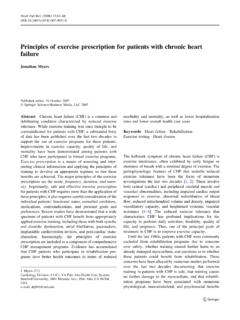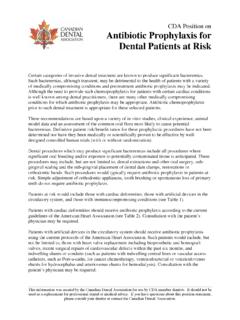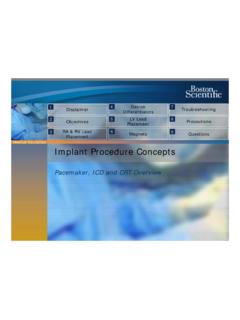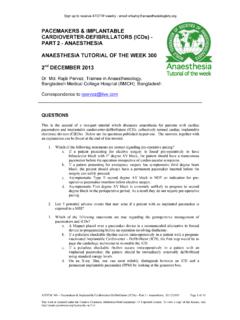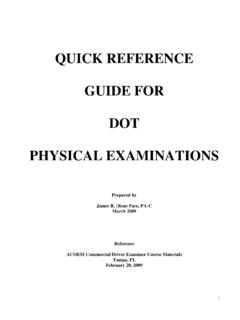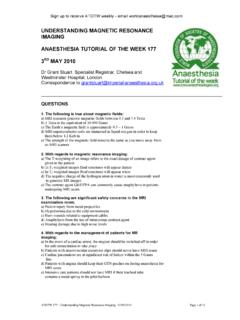Transcription of Sources of Electromagnetic Interference
1 Sources of Electromagnetic Interference (EMI) For Pacemakers, Implantable Cardioverter Defibrillators (ICDs), and Heart Failure Devices (CRT-Ds) Your implanted device is designed to work properly in the presence of most appliances and equipment. Most things you handle or work near every day will not cause a problem. But, some strong electrical or magnetic fields may affect your: pacemaker Implantable cardioverter defibrillator (ICD) Heart failure device (cardiac resynchronization therapy defibrillator or CRT-D) Attention heart failure patients: Your CRT-D is a special type of implantable cardioverter defibrillator (ICD). All information about interfer- ence that applies to ICDs also applies to your heart failure device (CRT-D). The guidelines in this document will help you understand which items are safe and which to stay away from. This document includes the most common items that cause Interference , but may not include every item that you handle or work near.
2 Note: If you have an ICD, some strong magnetic fields may cause your device to make beeping tones. If you hear beeping tones from your device you should: Immediately move away from the object that may be causing the beeping tones. Call your doctor to report the beeping tones. Talk to your doctor if you have more questions about an appliance, tool, medical procedure, or piece of equipment. Be sure to ask your doctor if you should follow any special instructions not listed here. You can also call Boston scientific Technical Services at 1-800-CARDIAC (1-800-227-3422). Sources of Electromagnetic Interference Listed by Category: Personal Items Kitchen and Household Items Do-It-Yourself Items Entertainment Items Travel and Environment Medical Procedures Miscellaneous Safe1 Personal Items Copy machines - There are no known or reported interactions.
3 Cordless phones - There are no known or reported interactions. However, you should avoid placing your household cordless phone receiver directly o ver your implanted device. Electric blankets - There are no known or reported interactions. Electric razors - There are no known or reported interactions. Fax machines - There are no known or reported interactions. Hair dryers - There are no known or reported interactions. Hand-held massagers - There are no known or reported interactions. Do not place directly over your implanted device. Heating pads - There are no known or reported interactions. Pagers - There are no known or reported interactions. Patient alert devices - There are no known or reported interactions. Personal computers - There are no known or reported interactions. Personal digital assistants (PDAs) - There are no known or reported interactions.
4 Radio-controlled clocks and watches - There are no known or reported interactions. These watches and alarm clocks automatically adjust themselves to a time-norm signal transmitted by radio signal. The watches serve only as receivers. Tanning beds - There are no known or reported interactions. Depending on how long it has been since implant, your doctor may recommend putting something over the implant site to protect the incision. Tattoos - There are no known or reported interactions. Thermolysis (hair removal) - There are no known or reported interactions. Precaution2 Cell phones - In certain cases, a cellular phone could affect an ICD or pacemaker s operation if it is closer than 6 inches (15cm) to the implanted device. This interaction is temporary, and moving the phone away from the implanted device will return it to proper function. To reduce the chance of any interaction, follow these precautions: Maintain a distance of at least 6 inches (15 cm) between the cellular phone and the implanted device; if the phone transmits more than 3 watts, increase the distance to a minimum of 12 inches (30 cm) Hold the cellular phone on the opposite side of the body from the implanted device Don t carry a cellular phone in a breast pocket or on a belt if it places the phone within 6 inches (15 cm) of the implanted device These precautions apply only to cellular phones, not to household cordless phones.
5 Avoid3 Body-fat measuring scales - Not recommended for use by patients with a pacemaker or an ICD. Electrolysis (hair removal) - Not recommended for use by patients with a pacemaker or an ICD. Magnetic mattresses/chairs - Not recommended for use by patients with a pacemaker or an ICD. Several magnetic- mattress/chair manufacturers recommend not using if you have a pacemaker or an ICD. May, 2003 Page 1 of 7 Safe1 Kitchen and Household Items Blenders - There are no known or reported interactions. Can openers - There are no known or reported interactions. Clothes dryers - There are no known or reported interactions. Convection ovens - There are no known or reported interactions. Electric brooms - There are no known or reported interactions. Electric knives - There are no known or reported interactions. Electric ovens - There are no known or reported interactions.
6 Food processors - There are no known or reported interactions. Gas ovens - There are no known or reported interactions. Microwave ovens - There are no known or reported interactions. Pest control systems - There are no known or reported interactions. Some manufacturers of pest control systems advertise the use of magnetic or ultrasound waves to repel rodents. They operate below levels that would affect implant- ed devices. Portable space heaters - There are no known or reported interactions. Sewing machines - There are no known or reported interactions. Toasters - There are no known or reported interactions. Vacuum cleaners - There are no known or reported interactions. Washing machines - There are no known or reported interactions. Precaution2 Induction ovens - Induction ovens can create large magnetic fields that could potentially deactivate or temporarily inhibit an ICD.
7 Pacemakers could have an issue with magnet rate pacing. Effects are only temporary. Recommend maintaining at least a 12-inch (30-cm) separation between the oven and your implanted device. Avoid3 None May, 2003 Page 2 of 7 Safe1 None Precaution2 Do-It-Yourself Items Arc welding equipment - Recommend maintaining at least a 24-inch (61-cm) separation between the cables, arc, transformer, and your implanted device. Keep all cables straight, close together, and extending a way from the body Wear dry, nonconductive gloves Do not weld alone Do not weld with rapidly repeating short bursts; wait a few seconds between welds If you experience symptoms of faintness, dizziness, nausea, etc., stop immediately and step away from the area or turn off the equipment Use extreme caution if welding energy exceeds the following values: 100 amps for TIG/MIG welding 250 amps for AC arc welding 250 amps for plasma welding 350 amps for DC arc welding Battery-powered, cordless power tools - Recommend maintaining at least a 12-inch (30-cm) separation between the motor and your implanted device.
8 Car engine repair - Alternators create magnetic fields, which could potentially deactivate or temporarily inhibit an ICD. Pacemakers are also affected by magnetic fields, but any effect will be temporary by moving away from the source of the magnetic field. Recommend maintaining at least a 12-inch (30-cm) separation between the motor and your implanted device. Avoid leaning directly o ver the alternator of a running car engine. Chain saws - Recommend maintaining at least a 12-inch (30-cm) separation between the motor and your implanted device. Drills - Recommend maintaining at least a 12-inch (30-cm) separation between the motor and your implanted device. Electric screwdrivers - Recommend maintaining at least a 12-inch (30-cm) separation between the screwdriver and your implanted device. Hedge clippers - Recommend maintaining at least a 12-inch (30-cm) separation between the motor and your implanted device.
9 High-power generators - Recommend maintaining at least a 36-inch (3 feet/91 cm) separation between the generator and your implanted device. Jigsaws - Recommend maintaining at least a 12-inch (30-cm) separation between the motor and your implanted device. Lawn mowers - Recommend maintaining at least a 12-inch (30-cm) separation between the motor and your implanted device. Leaf blowers - Recommend maintaining at least a 12-inch (30-cm) separation between the motor and your implanted device. Running motors and alternators - Alternators create magnetic fields, which could potentially deactivate or temporarily inhibit your ICD. Pacemakers are also affected by magnetic fields, but any effect will be temporary by moving away from the source of the magnetic field. Recommend maintaining at least a 12-inch (30-cm) separation between the motor and your implanted device. Avoid leaning directly o ver the alternator of a running car engine.
10 Small motor repair - Alternators create magnetic fields, which could potentially deactivate or temporarily inhibit your ICD. Pacemakers are also affected by magnetic fields, but any effect will be temporary by moving away from the source of the magnetic field. Recommend maintaining at least a 12-inch (30-cm) separation between the motor and your implanted device. Avoid leaning directly o ver the alternator of a running car engine. Snow blowers - Recommend maintaining at least a 12-inch (30-cm) separation between the motor and your implanted device. Soldering guns - Recommend maintaining at least a 12-inch (30-cm) separation between the soldering gun and your implanted device. Avoid3 Jackhammers - Mechanical pressure of large hammers can damage your implanted device and/or leads. The device may sense Electromagnetic Interference from small hammers, thus generating inappropriate therapy.

